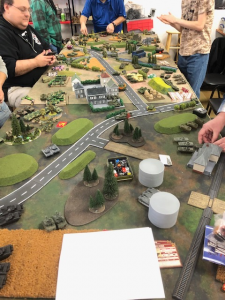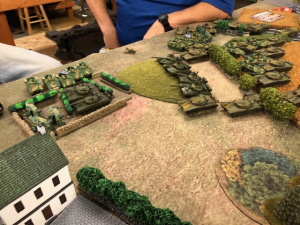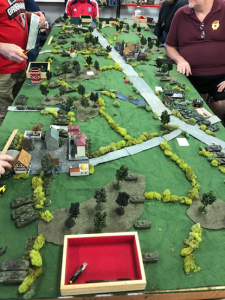
Designing a Mega-Battle
By Owen McGarel
The recent Toys for Tots Toy Drive gave me an opportunity to try my hand at designing a Mega-Battle. I define the “Mega-Battle” as a single game where you have four or more players and two or more boards. In designing a Mega-Battle, especially one for a Toys for Tots campaign, you want a game that will appeal to as many gamers as possible. Ideally, the game will allow for the inclusion of new players while still providing enough strategy elements for experienced players.
Crafting the Mega-Battle is different than designing an historical battle game. For an historical battle, you (or your comrades) are required to provide all the miniatures, and the objectives are defined by the historical conditions or outcome. While both types of larger scale battles can be enjoyable, my observation for Team Yankee or Flames of War is that players usually want to create their own army lists and field their own models. We have more Team Yankee than Flames of War players at Grognard Games, so that game system was chosen for the Toys for Tots Toy Drive. We have also recently completed an escalation campaign of Team Yankee that maxed out at 85 points, so I knew the players would have at least that many points worth of units. The plan for new players was to team them up with more experienced players, and provide them a unit or a portion of the experienced player’s army to command.
I used the Tanksgiving rules as a starting point. While I like some aspects of the rules, the main limitation of the game is that players can only field tanks (with a few exceptions). Not wanting to dissuade anyone from playing in the game, and to be as inclusive as possible, I initially put no restrictions on the types of units that a player could have in their army. After some players expressed concerns that there would be too much infantry on the board, I changed the requirement to the army having at least 65% of their points in tank units. (I would also limit the force on the board to 60% of the total points.)
My plan was to avoid a “static” game where players would line up their units behind hills and trees on either side of the board and fire away at each other. I wanted a game with maneuvering, that rewarded aggressive players who captured objectives. In addition, I hoped the game would entertain and last for approximately four hours.
Adding Asymmetry:
The primary way to avoid the static battle is to incorporate asymmetry. Battlefront does this in their More Missions scenarios by incorporating several different elements. These elements include:
- Use and placement of objectives
- Use of reserves and different rates of reserves (immediate, delayed, deep)
- Use of recon
- Ambushes
- Setup and first movement order
- Minefields
- Different victory conditions for attacker/defender
- Setup areas
- Reinforcement locations
- Turn limits to the game
I would use some of these same elements and add at least one major one of my own.
Objectives:
To encourage maneuvering, I wanted to include objectives in the Mega-battle. I decided to use a similar system to that in the Tanksgiving rules for objectives (reward one point for each objective controlled at the start of the turn), but I also included the “newer” method of capturing objectives (starting the turn within 4” of the objective and no enemy teams at the end of the turn). Objectives were not awarded on Turn 1 because of the advantages of the Attacker in moving first. Awarding points for the objective encourages objective play, and awarding points, instead of outright winning, results in a longer game.
To further encourage aggressive play, I awarded a point for the destruction of a Formation and not for a unit as is stated in the Tanksgiving rules.
Objective placement was also used to add strategy and asymmetry to the game. Four objectives would be placed on each side of playing area. Three objectives were to be placed exactly 12” from the back edge of the board. The final objective would be placed by the defender within 6” of the center line. This objective would require both the attacker and the defender to be aggressive on at least one section of the board. The procedure for objective placement is detailed in the Mega-Battle instructions.
Attacker/Defender:
The designation of an attacker/defender was also used to add asymmetry. For the attacker, I choose the advantages of:
- Setting up last
- Having the first turn (with no reduction in ROF or limits on bombardments)
The defender had the potentially devastating advantage of having an Ambush.
Reserves:
The players started with 60% of their force on the board and immediate reserves. Immediate reserves adds another asymmetric aspect and an element of the unknown to the game.
To add more strategic asymmetry, I added a new rule to the game that deployed the fourth player on each side as the Reinforcement Army. The deployment area for the Reinforcement Army needed to be chosen before the game began. It could overlap the other players deployed areas. The Reinforcement Army would roll three dice on the first turn and add one dice on each turn after that. (Somehow, I still managed to get only one unit when rolling five dice!)
New Rules:
The Battlegroup Morale rule was kept from Tanksgiving since it would keep players in the game longer. The following new rules were added:
- CALLING AIRCRAFT – Players can only deploy aircraft on a board when they have an HQ unit or a platoon leader.
- BURNING TANKS – Only tanks destroyed with a 5 or 6 firepower roll will remain on the board. (This rule is designed to reduce clutter on the board.) Bailed tank units that fail morale checks are also removed from the board.
- FORMATION MORALE – Unlike in normal Team Yankee, Units in reserve are counted for determination of good spirits for the formation. This rule was added to keep players from being eliminated too quickly in the game.
Terrain:
As mentioned previously, I didn’t want a terrain layout that encouraged the players to line up troops on each end of the board and fire at each other. To avoid this, the board should have terrain elements in perhaps half of the sections to limit line of sight. In the boards shown below, the forests, hills, and the town provide areas of cover. In general, I tried to create boards where a line of sight cannot be traced across the entire board.
The First Game
I divided the players up into two games on 4’ x 12’ boards because I felt this would be easier to manage and result in quicker games. It also had the advantage of not requiring the re-positioning of tables at our host, Grognard Games. The Warsaw Pact players were the attacking force in the first game. I volunteered to play the reinforcement army for the Warsaw Pact. I wanted to try a new formation, so my army list was built around a T-64 formation and tanks that employed the Songster missiles.
 |
 |
| The East Germans and British have virtually annihilated each other in the center. The Warsaw pact continues its advance on the left flank. | Meanwhile the Czechs advance on the right flank. |
 |
 |
| The American reinforcement army stabilizes the NATO right flank in the foreground… | But it’s too late, the Czech army overruns the center and it’s the end of the free nations! |
“Let’s Play Two” – Ernie Banks
The second game consisted of six players so the Reinforcement Army rule was not used. The NATO team was the attackers.
Outcome:
The Warsaw Pact won both games but since they were attacker in one game and defender in another, I’m not sure what lessons to draw from the game results!
Lessons Learned:
Feedback from the game was generally positive and most of the players were interested in another Mega-Battle. I was satisfied with how most of the setup and special rules functioned. The primary area where I would consider adjustments is to the recon moves. Recon deployment can have a large impact (as is the case in many tournament TY/FOW games). The defenders need to deploy their recon to limit the attacker deployment and to expand their deployment area. However, they do not want to be too aggressive and place units in exposed positions. The attackers want to exploit any weakness in the defender’s setup. These are difficult concepts for inexperienced players to employ. What it means for the Mega-Game designer is that you probably don’t want to include (or at least limit) recon if the game includes players with limited or no experience such as in a Convention setting. This issue was further highlighted by the Attacker setting up second and having the first turn.
With the use of immediate reserves and the reinforcement army, having 85 point armies did not result in a board that was overly crowded. Combat is deadlier in Team Yankee than FOW and units are eliminated quicker, so the board never felt too full. In retrospect, I feel that even if the armies contained higher levels of infantry, the board would not have felt overcrowded.
I would also change the position of the forward objective to be exactly 6” from the center line of the board. Having it closer tended to hurt the defenders as their recon moves were limited to staying outside of 16” of the objective.
The Burning Tanks rule effectively kept the wrecks from overwhelming the battlefield while providing some degree of cover.
The Reinforcement Army provided some interesting strategic options. It provided the NATO force with a reserve that slowed the Warsaw Pact advance at a key time.
In summary, the Mega-Battle provides an opportunity for new and experience players to enjoy FOW or TY in a slightly less competitive environment than the one-on-one type game. It also provides the opportunity to players to employ larger scale strategies and to use army lists that may not be suitable for smaller one on one games. Most importantly, the participants were able to “play with their little men” (as my wife says), collect a lot of toys for charity, and meet some new players!
Battle Rankings: Owen’s Mega-Battle rules can be download from the Battle Rankings Gaming Resource page -> https://battlerankings.com/gaming-resources/
Thank you to Grognard Games for hosting. You can find Grognard Games at 839 N. Roselle Rd, in Roselle on the Northeast corner of Nerge and Roselle Rd. The store is located right next to Uncle Bill’s Diner. Grognard can be reached by phone (847) 278-7538 or by email at info@grognardgames.com.
 |
Owen McGarel lives in Naperville, Illinois with his very understanding wife, Peggy. His wargaming affliction began in 1973, and since then he has been involved in roleplaying, board gaming, and miniature gaming. His first wargame was Strategy and Tactics issue 40 – Panzerarmee Afrika. Owen started playing Flames of War in 2012 and Team Yankee in 2017. His home is now overrun with plastic and resin models. Owen has three children, a daughter Ali in California, and two sons, Colin and Danny, in college at Northern Illinois University. All of them seem to have matured with only normal gaming tendencies. |



